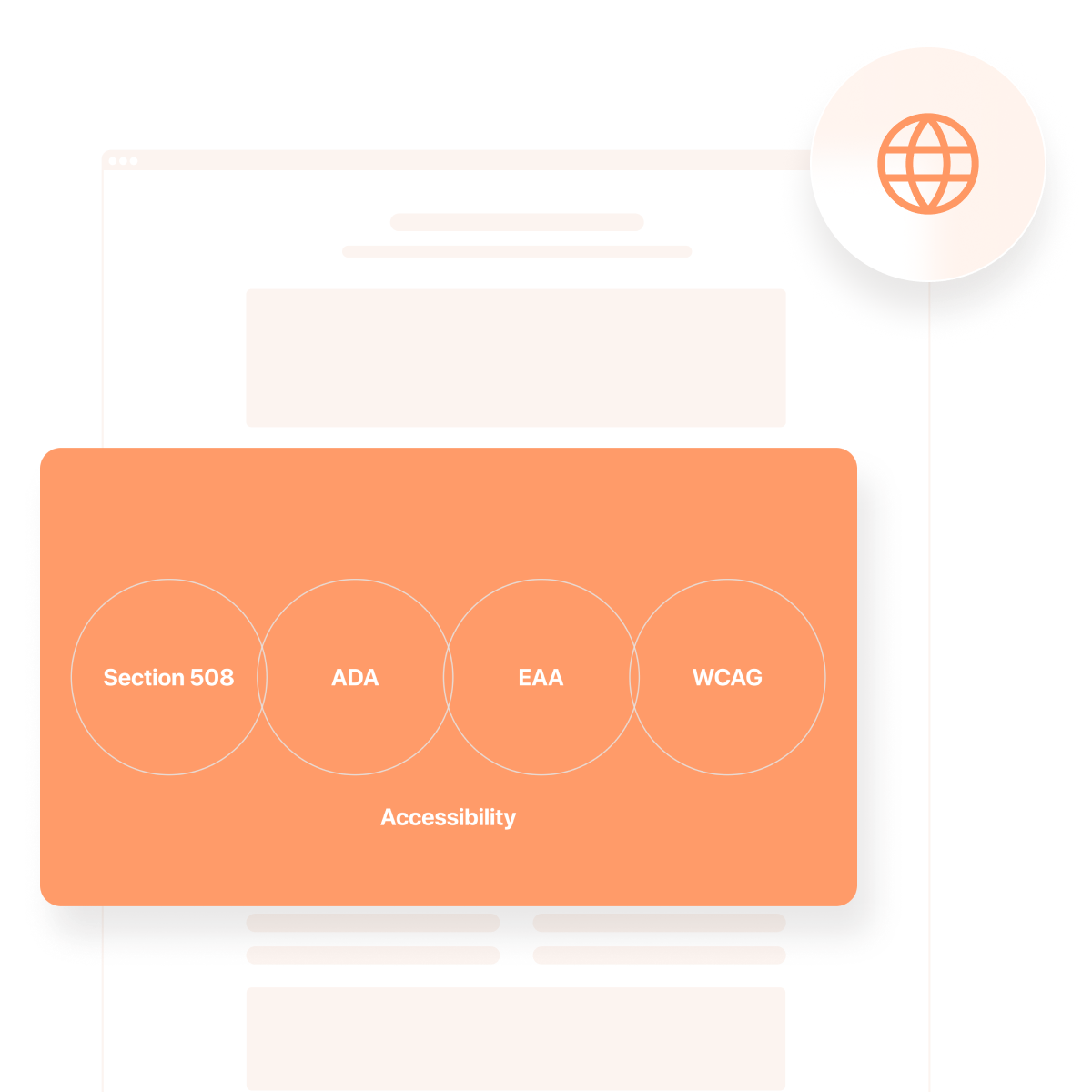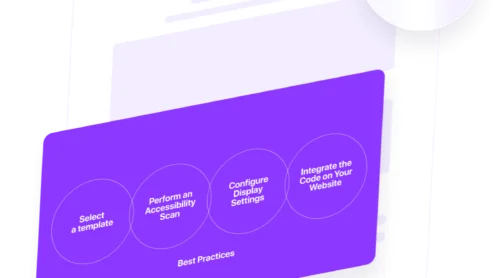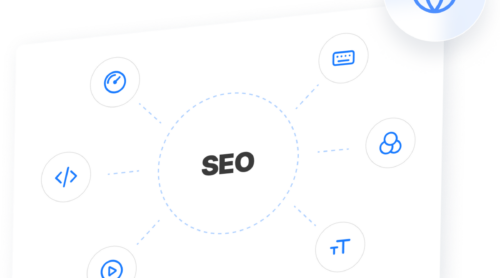As the demand for inclusive digital experiences grows, website accessibility has become a legal and ethical priority for organizations worldwide. Several major regulations govern how websites should be designed and maintained to ensure equal access for users with disabilities. Among the most referenced standards are the WCAG, ADA, Section 508, and the EAA — each originating from different jurisdictions and targeting specific audiences and use cases.
This article explores the key differences, overlaps, and requirements of these four major accessibility frameworks. Whether you’re updating an existing platform or building a new digital experience, understanding these standards is crucial for staying compliant and avoiding costly legal pitfalls.
While all four standards aim to improve accessibility, they differ in how they’re applied, who they’re enforced upon, and the technical details they follow.
| Standard | Jurisdiction | Primary Audience | Foundation | Level of Enforcement | Effective Timeline |
|---|---|---|---|---|---|
| WCAG (Web Content Accessibility Guidelines) | Global (used as a baseline in many regions) | All public and private websites | Developed by the W3C as a technical guideline | Voluntary but widely adopted and legally referenced | Latest version WCAG 2.2 released in 2023 |
| ADA (Americans with Disabilities Act) | United States | Public accommodations and businesses | Civil rights law prohibiting disability discrimination | Legally enforced through lawsuits and settlements | In effect since 1990, applied digitally via Title III |
| Section 508 | United States (federal scope) | Federal agencies, institutions, contractors | Amendment to the Rehabilitation Act of 1973 | Strictly enforceable under U.S. federal law | Mandatory compliance since January 2018 |
| EAA (European Accessibility Act) | European Union | Businesses offering digital goods and services | EU directive built on WCAG + European norms | Enforceable by member states with penalties | Went into full effect on June 28, 2025 |
To understand how these laws interconnect, it’s essential to start with the backbone of digital accessibility: WCAG. Let’s explore why it’s globally recognized and how it forms the foundation for nearly every accessibility requirement that follows.
Why WCAG Matters for Website Accessibility
The Web Content Accessibility Guidelines (WCAG) are the most widely accepted technical standards for ensuring that websites are usable by people with a wide range of disabilities. Created by the World Wide Web Consortium (W3C), WCAG provides a global framework for building inclusive digital environments through measurable, testable success criteria.
When we talk about a website being WCAG compliant, we mean that it meets specific levels of conformance defined by these guidelines. Although WCAG is not a law in itself, it is frequently cited or adopted within legal frameworks such as Section 508 in the U.S., the European Accessibility Act, and even by courts when interpreting ADA compliance.
Understanding WCAG conformance levels
WCAG defines three levels of accessibility, each with increasing requirements for inclusivity and technical rigor:
- Level A: The minimum level. Basic accessibility for some users but may exclude others.
- Level AA: The recommended standard for most organizations. Covers a wider range of disabilities and is the benchmark for legal reference.
- Level AAA: The highest standard. Includes the strictest criteria, often difficult to meet for all content types.
Most legal policies — including Section 508 and many European regulations — recommend or require conformance at Level AA. Achieving this level ensures that core content and functionality are accessible to the majority of users, including those with visual, auditory, motor, and cognitive impairments.
WCAG 2.1 and 2.2: What changed?
WCAG 2.1, released in 2018, expanded the accessibility guidelines to better address mobile technology, low vision, and cognitive disabilities. It introduced new success criteria for touch interactions, screen orientation, input mechanisms, and enhanced readability — responding to the needs of users interacting with digital content on modern devices.
WCAG 2.2, officially published in 2023, built further on these foundations by adding new criteria aimed at improving accessibility for users with cognitive impairments, low vision, and motor disabilities. Updates in WCAG 2.2 focus on easier navigation, reduced complexity of actions, and better operability for assistive technologies.
Organizations aiming for strong accessibility compliance now look to WCAG 2.1 or 2.2 as the modern standards. Adopting these guidelines helps businesses not only align with legal expectations globally but also deliver more usable, inclusive digital experiences for everyone. But how do these technical standards connect to legal obligations like the Americans with Disabilities Act (ADA)? Let’s explore that next.
How ADA Applies to Websites in the U.S.
The Americans with Disabilities Act (ADA) is a landmark U.S. civil rights law enacted in 1990 to protect individuals with disabilities from discrimination in public spaces, employment, transportation, and telecommunications. Over time, its reach has extended into the digital world, where courts have increasingly interpreted Title III of the ADA to apply to websites — especially those that offer goods, services, or information to the public.
Unlike WCAG, the ADA does not provide a specific technical standard for web accessibility. Instead, it sets a legal expectation for “reasonable accessibility”, which has been interpreted by the U.S. Department of Justice and federal courts to often align with WCAG 2.0 or 2.1 at Level AA. As such, while the ADA is a legal requirement and WCAG is a guideline, the two are often applied together in practice.
This lack of a formal rulebook can cause confusion for businesses. To clarify what ADA website compliance typically involves, let’s break down the most important legal and practical facts that shape enforcement and expectations.
Key legal facts about ADA website compliance
- Applies to: Businesses, nonprofits, and other entities that provide public-facing services, both physical and digital.
- Legal basis: Title III prohibits discrimination in places of public accommodation—including websites.
- No official technical spec: WCAG is used in court as the practical benchmark for compliance.
- Risk of litigation: Private lawsuits are the primary enforcement method, often resulting in costly settlements.
- Scope difference: ADA is broader than Section 508, which only governs federal agencies and contractors.
Understanding the difference between ADA and other compliance standards like Section 508 is critical for identifying your obligations. While both aim to improve access for people with disabilities, they serve different audiences and come from different regulatory frameworks. Let’s now examine Section 508 and how it applies in the federal sphere.
Explaining Section 508 and Federal Compliance
Section 508 of the Rehabilitation Act was originally passed in 1973 to ensure that people with disabilities could access federally funded technology and services. However, as digital platforms became central to communication and operations, the law was significantly updated in 1998 and again in 2017 to reflect the realities of modern electronic and information technologies (EIT).
The 2017 Section 508 Refresh realigned U.S. federal accessibility requirements by formally adopting parts of the WCAG 2.0 Level AA standards. This alignment provides a clear technical roadmap for federal agencies and their contractors, ensuring that websites, documents, software, and internal tools are accessible to users with a wide range of disabilities.
Section 508 compliance at a glance
- Applies to: Federal agencies, government contractors, grant recipients, and any entity receiving federal financial assistance.
- Accessibility benchmark: WCAG 2.0 Level AA success criteria.
- Enforcement methods: Self-evaluations, Department of Justice (DOJ) reports, internal agency audits, and formal complaints through accessibility coordinators.
- Difference from ADA: Section 508 governs federal digital infrastructure; ADA governs private-sector public-facing businesses and services.
- Common covered content: Agency websites, e-learning modules, procurement portals, internal employee software, and public documents like forms and instructions.
Compliance with Section 508 is not optional for federal entities. Failure to meet its standards can lead to administrative sanctions, funding delays, loss of contracts, and public accountability risks. Because of this, many organizations that interact with federal agencies voluntarily follow Section 508 standards even if not legally obligated to do so.
While Section 508 remains a model for accessible digital governance in the U.S., the conversation around accessibility is not limited to America. The European Union has established its own powerful legislation — the European Accessibility Act (EAA) — which affects businesses offering digital products and services across Europe. Let’s explore how the EAA compares to U.S. accessibility laws and standards.
The EAA and How It Differs From U.S. Accessibility Laws
As accessibility initiatives continue to gain momentum globally, the European Union has established its own far-reaching regulation: the European Accessibility Act (EAA). Officially adopted in 2019, the EAA is designed to remove barriers faced by people with disabilities in accessing digital products, services, and technologies across the European market. It aims to create a unified standard for accessibility throughout all EU member states, reducing fragmentation and enhancing the rights of consumers with disabilities.
The EAA came fully into effect on June 28, 2025. From that date, private and public sector organizations must ensure that certain goods and services meet harmonized accessibility requirements, or they risk facing penalties imposed by individual EU member states. Businesses providing e-commerce platforms, banking apps, e-books, public transport services, and other digital offerings will all be required to comply, regardless of whether they have a physical office within the European Union.
Importantly, the EAA builds upon the principles of WCAG 2.1 Level AA — adopting more modern accessibility benchmarks than the U.S. Section 508, which still references WCAG 2.0. However, the EAA goes beyond web content by extending its reach to physical products such as ATMs, self-service kiosks, and payment terminals, making it broader in scope than U.S. legislation like the ADA or Section 508.
Key differences between the EAA and U.S. accessibility laws
- Scope: Covers both private and public sectors across EU member states, unlike Section 508, which applies only to federal agencies in the U.S.
- Coverage: Encompasses digital services and physical products, not limited solely to websites and online content.
- Technical baseline: Built on WCAG 2.1 Level AA, offering updated guidelines compared to the older WCAG 2.0 framework referenced in Section 508.
- Enforcement: Each EU country must establish national penalties for non-compliance.
- Impact on businesses: Any company selling digital goods or services to the EU market — whether located inside or outside of Europe — must comply with the EAA.
The EAA reflects a major step toward creating an accessible digital economy across Europe, combining consumer protection with a strong focus on equality and inclusion. It will impact both EU-based businesses and international companies serving European customers, encouraging widespread adoption of accessibility best practices worldwide.
Now that we’ve explored the major compliance standards in the U.S. and Europe, the next step is learning how to evaluate your website’s accessibility status and take effective action. Let’s move on to practical strategies for checking and improving your digital accessibility compliance.
How to Check and Improve Your Accessibility Compliance
With different regulations like the ADA, Section 508, WCAG, and the EAA setting varying standards for accessibility, evaluating your website’s compliance can feel overwhelming. Fortunately, a structured approach combined with the right accessibility audit tools makes it possible to meet multiple legal requirements through one unified strategy.
Although each regulation has specific nuances, most share a common technical foundation based on WCAG 2.1 or 2.2 Level AA. This means that a thorough accessibility evaluation based on WCAG principles can simultaneously help you align with ADA, Section 508, and EAA expectations. Here’s how to get started:
Steps to evaluate and improve your website’s accessibility
- Conduct an automated accessibility scan. Use trusted tools like Axe, WAVE, or Lighthouse to detect basic WCAG violations such as missing alt text, poor color contrast, or unlabeled form fields.
- Perform manual testing. Automated tests often miss complex issues. Manual checks for keyboard navigation, screen reader compatibility, and dynamic content behavior are essential.
- Review conformance levels. Focus on achieving at least WCAG 2.1 Level AA compliance, which covers most legal standards globally.
- Prioritize usability improvements. Beyond technical fixes, ensure that users with disabilities can navigate, understand, and interact with your website easily.
- Document your efforts. Keep accessibility statements, audit logs, and remediation plans on record in case of legal challenges.
- Establish a maintenance schedule. Accessibility is not a one-time task. Plan for regular audits, updates, and employee training sessions to maintain legal compliance over time.
Numerous accessibility audit tools, consulting firms, and compliance platforms now offer comprehensive services that check against multiple frameworks at once. Investing in these resources ensures your website not only passes legal requirements but also offers a genuinely inclusive experience to all users — boosting your reputation, reach, and operational resilience.
Step-by-Step: How to Apply EAA Compliance with Elfsight
Meeting EAA compliance requirements becomes simple with the help of Elfsight’s accessibility widget. This user-friendly tool requires no coding skills and equips your website with a full-featured digital accessibility service. With ready-to-use accessibility profiles and a built-in audit checker, it helps address critical points on the legal accessibility checklist while enhancing the browsing experience for everyone.
Follow these steps to configure and implement the accessibility widget via the Elfsight interface:
- Start with a Template. Access the Elfsight editor and pick a template. Press “Continue with this template” to proceed to editing.
- Run an Accessibility Check. On the first screen, enter your website’s URL into the testing field and hit “Check”. The widget uses Lighthouse to evaluate your accessibility level and displays a detailed compliance report.
- Adjust Appearance and Behavior. Head over to the “Settings” tab to set language preferences, change button labels, choose display position, and define how long visitor preferences are remembered. You can also include your own CSS or JavaScript for further customization.
- Add the Widget to Your Website. Click the “Add to website for free” button to get your embed code. Paste it into your website’s backend, ideally before the closing </body> tag. Save the changes and publish the update to enable the widget across your website.
After setup, your website will be equipped with a powerful accessibility feature that helps meet EAA criteria while offering a better experience for all types of users.
With proactive auditing and ongoing improvements, you can turn accessibility compliance into a competitive advantage rather than a reactive burden. Now, let’s wrap up by reviewing the key points about the major accessibility standards and the best practices for staying ahead.
Make your website accessible to all — build your own widget right now!
Conclusion
Understanding the differences among WCAG, ADA, Section 508, and the EAA is critical for meeting accessibility requirements. While WCAG offers the technical base, each law — whether focused on U.S. businesses or European markets — adds specific obligations. Focusing on WCAG and ADA compliance ensures broad coverage, while keeping Section 508 ADA requirements in mind is crucial for those working with federal agencies.
Long-term success in accessibility means more than passing audits. A user-centered accessibility approach and regular updates aligned with WCAG 2.1 or higher form the backbone of a long-term compliance strategy. By prioritizing inclusion now, businesses can meet legal standards and build a better digital future for all users.







